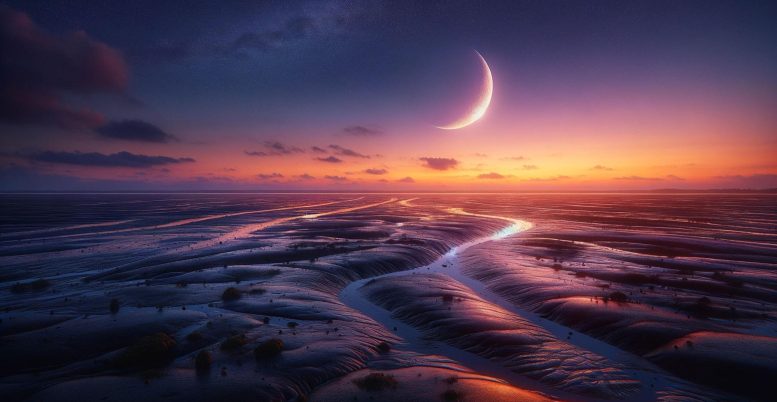Scientific Assumptions Shattered: Eukaryotes Found to be 1.64 Billion Years Old on Earth

A pioneering research spearheaded by UC Santa Barbara and McGill University has debunked earlier beliefs on the evolution of eukaryotic organisms including animals, plants and fungi. The study found that these organisms could be traced back to 1.64 billion years ago and were diverse even then. This game-changing evidence was discovered through recent microfossil findings. As such, this has significantly widened the believed environmental conditions and timeline where the eukaryote diversification occurred, giving a new perspective on the origins and progress of complex life on Earth.
Imagine a serene late summer evening at the Paleoproterozoic era, taking inspiration from DALL-E’s depiction. The Northern Territory of Australia rests after sunset, all is silent and still with no sign of fauna or flora. The only signs of life are scant biological residue in a few ponds and puddles which hold a rich microbial community, a window into our ancient lineage.
A recent report with descriptions of superbly reserved microfossils has confirmed that there existed a variety of forms of eukaryotic organisms as far back as 1.64 billion years ago. The report was published in the journal, Papers in Paleontology, and it illustrates the account of an assortment of eukaryotic fossils from an early phase of the lineage’s evolutionary history. Scientists have defined four new taxa and there is evidence proving the presence of advanced traits in these early eukaryotes.
Leigh Anne Riedman, the primary author and Assistant Researcher at UCSB’s Department of Earth Science stressed that, “These are among the oldest eukaryotes that have ever been discovered. At the time of the initial discoveries, we already observed a significant amount of diversity.”
The Eukarya domain is one of the primary life domains and houses fungi, animals, plants and other groups whose cells contain a membrane-bound nucleus like protists and seaweeds. Existing theories proposed that diversification occurred around 800 million years ago as they believed early eukaryotes of the late Paleoproterozoic era to be somewhat similar in characteristics. However, the study led to the finding of a diverse collection of complex and interesting fossils in rocks nearly twice as old.
Prior studies hinted that eukaryotes evolved during this era, however, the diversity was vaguely understood. Riedman studied this in greater detail by heading to the Outback in late 2019 and collected approximately 430 samples from eight cores outsourced by a prospecting company. These samples became part of the library at the Northern Territory Geological Survey. Two cores with about 15 million years of significant deposition were used in this study, which covered roughly 500 meters of stratigraphy or 133 million years.
After returning to the U.S. with shale and mudstone, remnants of an age-old coastal ecosystem with varying environments between shallow, subtidal mudflats and coastal lagoons, Riedman examined the preserved microfossils under a microscope. Riedman hoped to uncover distinctive cellular features that could throw light on the cellular developments of the time.
The researchers were astonished at the variety and complexity of the fossils. In total, they recorded 26 taxa, including 10 hitherto unknown species. The team also unexpectedly found evidence of features similar to complex cytoskeletons and cell walls produced from bounded fibers in certain microbes. There was also evidence suggesting the presence of internal vesicles where plates were formed, potentially ancestors to modern eukaryotic cells’ Golgi bodies.
Some cells displayed complexity with a miniature trapdoor. Certain microbes are capable of forming cysts to endure adverse environmental conditions and need to create an opening in their shields to emerge, indicating a level of sophistication. This exceptional functionality is a testament to the impressive complexity observed in these early eukaryotes.
Many people in the field had thought this ability emerged later, and the evidence for it in this assemblage further emphasizes how diverse and advanced eukaryotes were even at this early juncture. “The assumption has always been that this is around the time that eukaryotes appeared. And now we think that people just haven’t explored older rocks,” said co-author Susannah Porter, an Earth science professor at UC Santa Barbara.
This paper is part of a larger project investigating early eukaryote evolution. Riedman and Porter want to know in what environments early eukaryotes were diversifying, why they were there, when they migrated to other places, and what adaptations they needed in order to fill those new niches.
A big part of this effort involves understanding when different characteristics of eukaryotes first arose. For instance, the authors are quite interested to learn whether these organisms were adapted to oxygenated or anoxic environments. The former would suggest that they had an aerobic metabolism, and possibly mitochondria. Every modern eukaryote that’s been found descends from ancestors that possessed mitochondria. This suggests that eukaryotes acquired the organelle very early on, and that it provided a significant advantage.
Riedman and Porter are currently working on a fresh account of eukaryote diversity through time. They’ve also collected even older samples from Western Australia and Minnesota. Meanwhile, their geochemist collaborators at McGill are spearheading a study on oxygen levels and preferred eukaryote habitats, aspects that could shed light on their evolution.
“These results are a directive to go look for older material, older eukaryotes, because this is clearly not the beginning of eukaryotes on Earth,” Riedman said.




